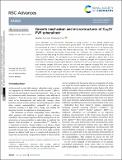Growth mechanism and microstructures of Cu2O/PVP spherulites
Abstract
Cu2O spherulites are solvothermaly fabricated by using Cu(NO3)2 as the starting material and polyvinylpyrrolidone (PVP) as a multifunctional growth agent. The specimens at different growth stages are investigated by using X-ray diffraction, electron microscopy, energy dispersive X-ray spectroscopy, soft X-ray emission spectroscopy and infrared spectroscopy. The formation mechanism of Cu2O spherulites is proposed accordingly. Hierarchically, the spherulites are composed of needle-like submicron-rods lying along the radial orientations. The submicron-rods are constructed by piling up of small Cu2O/PVP spheres. The embedded Cu2O nanocrystallites can generate a dipolar field in each along the [100] direction. They deposit at the surface of a negatively charged PVP-containing spherical core, and self-oriented along the radial directions. Therefore, all the Cu2O nanocrystallites would have their positively charged (100) facet facing to the core and their negatively charged (00) facet turning towards to the spherulite surface, leading to a negatively charged surface of spherulites. Unlike randomly oriented nanocrystallites embedded in polymer microspheres, the spherulites would not undergo surface recrystallisation into a single crystal shell due to the restricted potential of local shift and rotation of the nanocrystallites by the Coulomb force from the core. This work provides new perspective towards the formation of spherulites and their structural properties.
Citation
Sun , W & Zhou , W 2022 , ' Growth mechanism and microstructures of Cu 2 O/PVP spherulites ' , RSC Advances , vol. 12 , no. 31 , pp. 20022-20028 . https://doi.org/10.1039/D2RA03302J
Publication
RSC Advances
Status
Peer reviewed
ISSN
2046-2069Type
Journal article
Description
WS wishes to thank University of St Andrews for a CSC-St Andrews scholarship.Collections
Items in the St Andrews Research Repository are protected by copyright, with all rights reserved, unless otherwise indicated.

